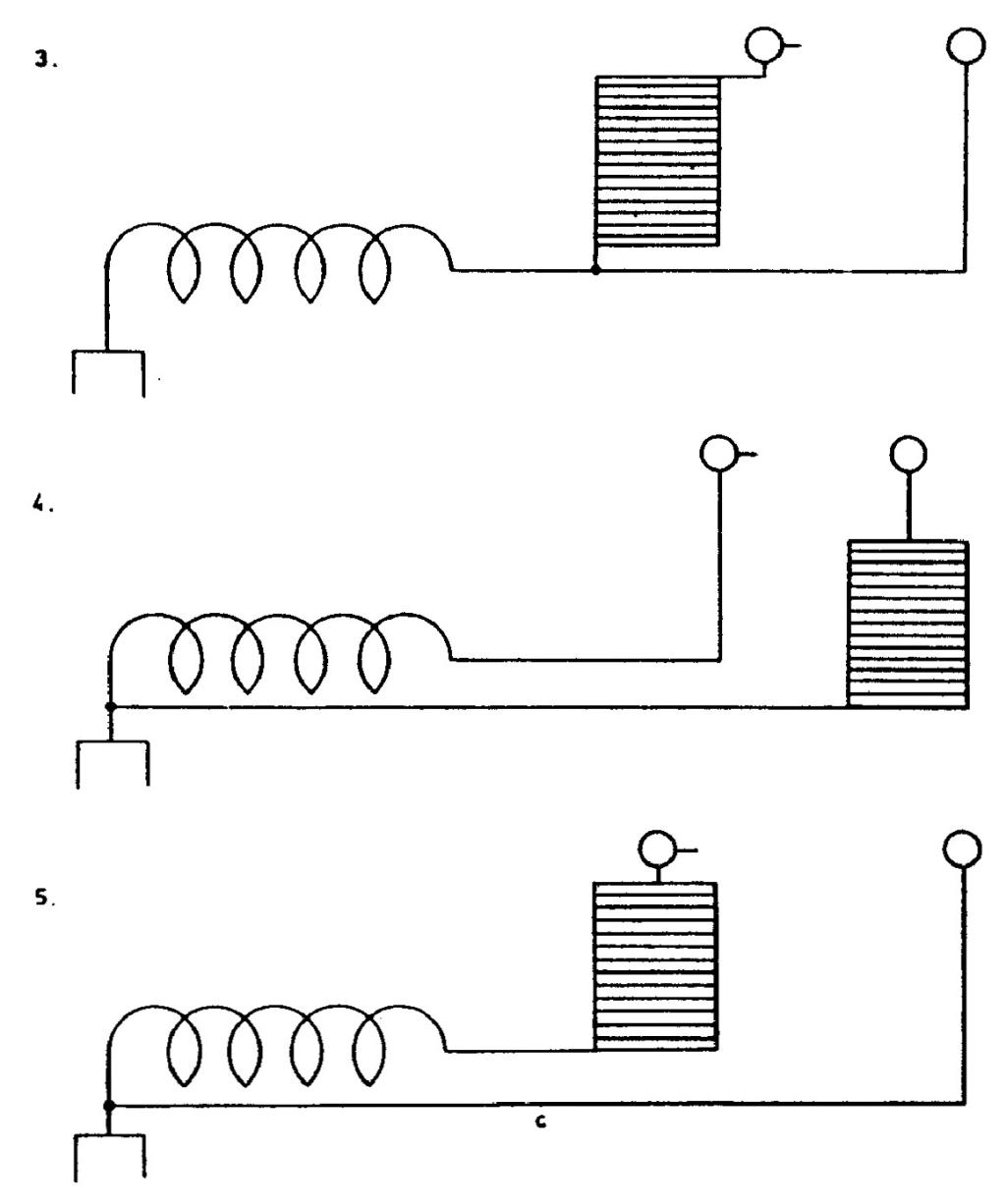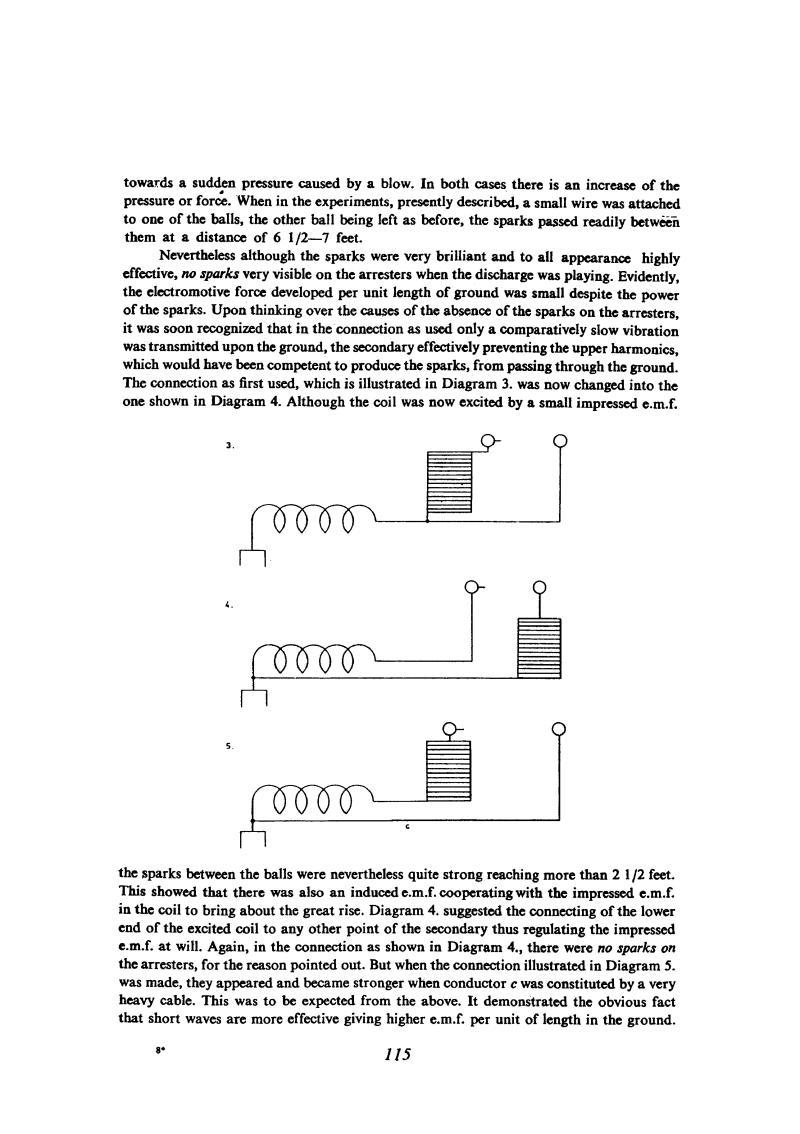
Nikola Tesla Books
towards a sudden pressure caused by a blow. In both cases there is an increase of the pressure or force. When in the experiments, presently described, a small wire was attached to one of the balls, the other ball being left as before, the sparks passed readily between them at a distance of 6 1/2 - 7 feet.
Nevertheless although the sparks were very brilliant and to all appearance highly effective, no sparks very visible on the arresters when the discharge was playing. Evidently, the electromotive force developed per unit length of ground was small despite the power of the sparks. Upon thinking over the causes of the absence of the sparks on the arresters, it was soon recognized that in the connection as used only a comparatively slow vibration was transmitted upon the ground, the secondary effectively preventing the upper harmonics, which would have been competent to produce the sparks, from passing through the ground. The connection as first used, which is illustrated in Diagram 3. was now changed into the one shown in Diagram 4. Although the coil was now excited by a small impressed e.m.f. the sparks between the balls were nevertheless quite strong reaching more than 2 1/2 feet.
This showed that there was also an induced e.m.f. cooperating with the impressed e.m.f. in the coil to bring about the great rise. Diagram 4. suggested the connecting of the lower end of the excited coil to any other point of the secondary thus regulating the impressed e.m.f. at will. Again, in the connection as shown in Diagram 4., there were no sparks on the arresters, for the reason pointed out. But when the connection illustrated in Diagram 5. was made, they appeared and became stronger when conductor c was constituted by a very heavy cable. This was to be expected from the above. It demonstrated the obvious fact that short waves are more effective giving higher e.m.f. per unit of length in the ground.
8*
115
Tesla: âMethod of intensifying and utilizing effects transmitted through natural mediaâ, U.S. Patent, 685 953, Nov. 5, 1901, Appl. June 24, 1899, P-297.
July 30
To try and verify his hypothesis about the rejection of harmonics with appropriate coils, Tesla changed the connection of his âextra coilâ as shown in Figs. 4 and 5. To understand his way of proceeding one must take into account his ideas from 1893(6) concerning the induction of earth currents via an aerial-earth system. However, the standing waves in terms of which he tried to explain the arcing over the lightning arresters cannot be significant at these frequencies.
July 30
Along with the application of new "additional coil" Tesla repeats the experiments with his oscillator and after the usual matching procedure he achieves better results than in previous cases. He obtains sparks of approximately 2.5 meters in length. He considers the conductor curve radius influence on the current streamers appearance phenomenon. On this occasion he emphasizes the importance of current streamers elimination which create the losses and reduce the system efficiency for wireless transmission.
The conclusion on current streamers is correct, but that could not be said for the explanation of the advantage of having an elevated wire with capacitive loading in relation to the same wire without loading. In consideration of transitional events in oscillator circuits, he again separates the coil validity factor influence from the excitation influence (sudden current changes) at the instance of spark appearance and interruption in an oscillator arcing device.
Commenting on the non-existence of sparks on lightning arresters, he makes the judgment that the reasons for this are the high harmonics blocked by corresponding coils and they do not react to ground. In an effort to check his assumption, he changes "additional coil" connecting method according to Figure 4 and obtains a new oscillator configuration. Unfortunately, the experiment description is not complete, and it is not known whether he made some changes in the primary circuit in order to achieve, with connections in Fig. 3, 4, the maximum oscillator effect. The difference between connections in Figs. 4, 5 is that in the first the grounded sphere is excited via "additional coil", and in the second only the grounded sphere is excited. It is possible that the sphere system without additional coil oscillates at a higher frequency, but one cannot draw reliable conclusions without a deeper analysis.
The same day he devoted some time to design and calculation of a high frequency transformer for a high receiver. He intended to use it for operation with a "fast vibrating" system (probably as the one in Fig. 5). As far as design is concerned, the receiver was probably similar to the one of July 28.
As during many previous days, Tesla, this time as well, studies several problems. He found the time to study also the variation of voltage on supply transformer primary at various capacitive loadings. He found the voltage variation that points to the transformer impedance increase, although the secondary reactive impedance was being reduced.


